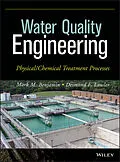Explains the fundamental theory and mathematics of water and wastewater treatment processes
By carefully explaining both the underlying theory and the underlying mathematics, this text enables readers to fully grasp the fundamentals of physical and chemical treatment processes for water and wastewater. Throughout the book, the authors use detailed examples to illustrate real-world challenges and their solutions, including step-by-step mathematical calculations. Each chapter ends with a set of problems that enable readers to put their knowledge into practice by developing and analyzing complex processes for the removal of soluble and particulate materials in order to ensure the safety of our water supplies.
Designed to give readers a deep understanding of how water treatment processes actually work, Water Quality Engineering explores:
* Application of mass balances in continuous flow systems, enabling readers to understand and predict changes in water quality
* Processes for removing soluble contaminants from water, including treatment of municipal and industrial wastes
* Processes for removing particulate materials from water
* Membrane processes to remove both soluble and particulate materials
Following the discussion of mass balances in continuous flow systems in the first part of the book, the authors explain and analyze water treatment processes in subsequent chapters by setting forth the relevant mass balance for the process, reactor geometry, and flow pattern under consideration.
With its many examples and problem sets, Water Quality Engineering is recommended as a textbook for graduate courses in physical and chemical treatment processes for water and wastewater. By drawing together the most recent research findings and industry practices, this text is also recommended for professional environmental engineers in search of a contemporary perspective on water and wastewater treatment processes.
Autorentext
MARK M. BENJAMIN, PhD, is Professor of Environmental Engineering at the University of Washington. A Fulbright Fellow, Dr. Benjamin is an expert in physical and chemical treatment processes. His research examines the behavior of natural organic matter and its removal from potable water sources. Moreover, he has developed adsorption-based processes for the removal of metals, natural organic matter, and other contaminants from solutions. A major focus of his current research has been the membrane treatment of drinking water.
DESMOND F. LAWLER, PhD, holds the Nasser I. Al-Rashid Chair in Civil Engineering at the University of Texas and is a member of the University's Distinguished Teaching Academy. Throughout his career, his research and teaching have focused on physical-chemical treatment processes. The research has emphasized particle removal in drinking water and wastewater but has also involved gas transfer, precipitation, oxidation, and desalination. Fourteen of his Ph.D. advisees hold academic positions, while his numerous M.S. research graduates work in consulting firms and government agencies.
Inhalt
Preface xxi
Acknowledgments xxv
Part I Reactors and Reactions In water Quality Engineering
1 Mass Balances 3
1.1 Introduction: The Mass Balance Concept 3
1.2 The Mass Balance for a System with Unidirectional Flow and Concentration Gradient 7
1.3 The Mass Balance for a System with Flow and Concentration Gradients in Arbitrary Directions 20
1.4 The Differential Form of the Three-Dimensional Mass Balance 24
1.5 Summary 25
2 Continuous Flow Reactors: Hydraulic Characteristics 29
2.1 Introduction 29
2.2 Residence Time Distributions 30
2.3 Ideal Reactors 42
2.4 Nonideal Reactors 48
2.5 Equalization 62
2.6 Summary 70
3 Reaction Kinetics 81
3.1 Introduction 81
3.2 Fundamentals 82
3.3 Kinetics of Irreversible Reactions 88
3.4 Kinetics of Reversible Reactions 99
3.5 Kinetics of Sequential Reactions 107
3.6 The Temperature Dependence of the Rates of Nonelementary Reactions 114
3.7 Summary 115
4 Continuous Flow Reactors: Performance Characteristics with Reaction 121
4.1 Introduction 121
4.2 Extent of Reaction in Single Ideal Reactors at Steady State 121
4.3 Extent of Reaction in Systems Composed of Multiple Ideal Reactors at Steady State 130
4.4 Extent of Reaction in Reactors with Nonideal Flow 135
4.5 Extent of Reaction Under Non-Steady-Conditions in Continuous Flow Reactors 141
4.6 Summary 146
Part II Removal of Dissolved Constituents From Water
5 Gas Transfer Fundamentals 155
5.1 Introduction 155
5.2 Types of Engineered Gas Transfer Systems 159
5.3 Henry's Law and Gas/Liquid Equilibrium 162
5.4 Relating Changes in the Gas and Liquid Phases 170
5.5 Mechanistic Models for Gas Transfer 170
5.6 The Overall Gas Transfer Rate Coefficient KL 179
5.7 Evaluating kL kG KL and a: Effects of Hydrodynamic and Other Operating Conditions 187
5.8 Summary 196
6 Gas Transfer: Reactor Design and Analysis 207
6.1 Introduction 207
6.2 Case I: Gas Transfer in Systems with a Well-Mixed Liquid Phase 207
6.3 Case II: Gas Transfer in Systems with Spatial Variations in the Concentrations of Both Solution and Gas 226
6.4 Summary 241
7 Adsorption Processes: Fundamentals 257
7.1 Introduction 257
7.2 Examples of Adsorption in Natural and Engineered Aquatic Systems 262
7.3 Conceptual Molecular-Scale Models for Adsorption 266
7.4 Quantifying the Activity of Adsorbed Species and Adsorption Equilibrium Constants 268
7.5 Quantitative Representations of Adsorption Equilibrium: The Adsorption Isotherm 269
7.6 Modeling Adsorption Using Surface Pressure to Describe the Activity of Adsorbed Species 296
7.7 The Polanyi Adsorption Model and the Polanyi Isotherm 306
7.8 Modeling Other Interactions and Reactions at Surfaces 314
7.9 Summary 320
8 Adsorption Processes: Reactor Design and Analysis 327
8.1 Introduction 327
8.2 Systems with Rapid Attainment of Equilibrium 328
8.3 Systems with a Slow Approach to Equilibrium 340
8.4 The Movement of the Mass Transfer Zone Through Fixed Bed Adsorbers 354
8.5 Chemical Reactions in Fixed Bed Adsorption Systems 356
8.6 Estimating Long-Term Full-Scale Performance of Fixed Beds from Short-Term Bench-Scale Experimental Data 357
8.7 Competitive Adsorption in Column Operations: The Chromatographic Effect 359
8.8 Adsorbent Regeneration 365
8.9 Design Options and Operating Strategies for Fixed Bed Reactors 366
8.10 Summary 369
9 Precipitation and Dissolution Processes 379
9.1 Introduction 379
9.2 Fundamentals of Precipitation Processes 380
9.3 Precipitation Dynamics: Particle Nucleation and Growth 384
